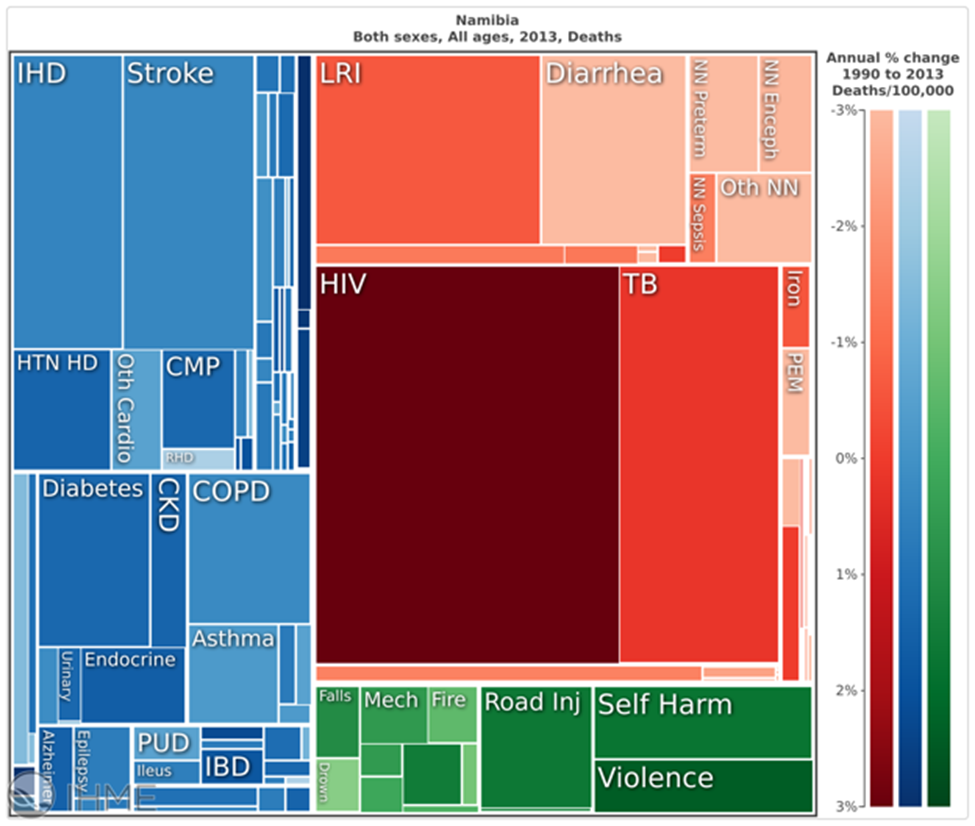In Namibia, population health is at the core of the country’s development agenda. Its National Health Policy Framework specifies that health and social well-being are fundamental human rights. In addition, Namibia’s National Development Plan spells out as priority areas improved and quality health service provisions. With these commitments in mind, universal health coverage is a goal against which Namibia will be assessing performance.
To provide Namibia with actionable evidence to guide the country’s universal health coverage agenda, the Institute for Health Metrics and Evaluation (IHME), in partnership with the World Health Organization (WHO), Namibia, recently published the report “Namibia: State of the Nation’s Health: Findings from the Global Burden of Disease.”
Based on the Global Burden of Disease Study 2013, the report examines population health trends in Namibia from 1990 and 2013. The report presents important causes of health loss and their risk factors in ways that are informative to policymaking, particularly when considering the country’s efforts to improve population health. The country WHO Representative, Prof. Monir Islam, notes the “information presented in this report will be particularly useful to guide the country’s decision-makers to prioritize critical areas for service provision as well as cost-effective allocation of scarce resources.”
The report documents how, over the past 23 years, the country has made steady progress in tackling important causes of mortality and morbidity, such as maternal and childhood illnesses as well as other priority communicable diseases such as HIV/AIDS, malaria and tuberculosis. However, despite this progress, HIV/AIDS still exerts a heavy toll as a driver of population health loss in the country.

At the same time, non-communicable diseases and injuries are also increasingly becoming major contributors to sickness and deaths in Namibia, warranting heightened attention from policymakers. Unless there are concerted efforts geared toward prevention and treatment of these diseases, the country’s universal health coverage aspirations could fall short, and gains that have been so painstakingly achieved could be threatened.
The report also highlights how important risk factors that are associated with non-communicable diseases and injuries – such as harmful alcohol use and obesity – are also on the rise. Here, health systems stewards in Namibia have an opportunity to intervene by putting in place policies that reduce the impact of preventable risk factors on population health.

The question of how to finance health service provisions in an emerging landscape characterized by competing health priorities is becoming increasingly important. By understanding the primary causes of the burden of disease and their risk factors, policymakers are better equipped to respond effectively.
“This report provides the Namibian health system with a roadmap toward achieving universal health coverage and securing the progress that has been realized so far,” said the WHO’s Prof. Monir Islam.
Namibia has demonstrated strong commitment toward improving the health of its people over the past decades. By embracing an evidence-based planning and implementation approach, further progress will be achieved. “Namibia: State of the Nation’s Health: Findings from the Global Burden of Disease,” is available here: http://www.healthdata.org/policy-report/namibia-state-nations-health